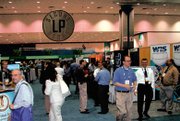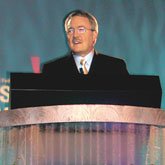Retail Crime Increased as U.S. Economy Worsened
Crimes against retailers are increasing, and they are costing the economy billions of dollars, said criminologist Dr. Richard Hollinger, who spoke at the National Retail Federation’s Loss Prevention Conference & Expo, held June 15–17 at the Los Angeles Convention Center.
Total retail losses increased to $36.5 billion in 2008, up from $34.8 billion in 2007. Hollinger based his remarks on preliminary findings from an upcoming study conducted in partnership between the NRF and the University of Florida, where Hollinger teaches. The professor said the study will be released around the Labor Day holiday.
Hollinger blamed the increase in crimes against retailers on a worsening economy, which has forced retailers to cut back on their security efforts. During his keynote speech, he noted burglaries and property crimes against retailers are some of the most common crimes in the United States, but they may not be taken seriously enough by the public. “I tell my criminology students, if you really want to study crime, go to a mall,” he said at the event, which drew more than 2,400 loss-prevention executives, law-enforcement officials and retailers.
Fashion stores are among the hardest hit by crime, Hollinger said. The retailers faring the worst are optical stores, children’s apparel stores, and discounters and mass merchants.
The poor economy might be pouring gasoline onto the often combustible situation of retail crime, according to William Titus, vice president of loss prevention at Sears Holding Corp. At a convention seminar, he said burglaries have shot up more than 30 percent at some retailers this year. Another leading loss-prevention executive said he thought loss-prevention workers have been doing a good job at containing retail crime.
“I’ve been surprised it hasn’t gotten worse,” said Gary Manson, former vice president of loss prevention for Neiman Marcus Group. “It’s remained low. I have to see whether this crime rate grows in the next 12 months.” Manson was honored on June 15 with the NRF’s “Ring of Excellence” award for an accomplished career of 36 years in loss prevention. Sandy Katz, founder of SFK Consulting, also was awarded a “Ring of Excellence” award.
Law-enforcement officials also had the containment of retail crime on their minds. Marcy M. Forman, director of the office of investigations for U.S. Immigration and Customs Enforcement, announced the launch of a pilot program between ICE and the NRF. The program will assess the threat level of organized retail crime in several cities, including Los Angeles, Houston, Miami and New York. According to Forman, many organized retail crime gangs are staffed by foreign nationals and are headquartered overseas. Organized gangs of thieves are said to steal thousands of dollars from stores in a single day. ICE will use information provided by the NRF to prosecute these gangs. Preliminary results from the pilot program could be released in 2010.
Los Angeles Police Chief William J. Bratton also spoke at the conference, pledging added cooperation with loss-prevention professionals to help them battle crimes against retailers. “You were not invited to the tent [in the past],” he said of the competitive relationship between law enforcement and loss-prevention professionals. “But we have matured. We have come to understand that we are in a coequal partnership.”
The three-day conference was attended by loss-prevention professionals from across the Western United States, as well as vendors exhibiting technology to help prevent retail crime. Companies such as New Jersey–based Agilence and SysRepublic, which has an office in Redondo Beach, Calif., offered security systems that use video, Internet and data mining to track crime in stores.
The conference also featured seminars for independent retailers on safeguarding boutiques. Los Angeles Police Department Detective Daniel Nee said some ways to deter crime were simple. One was remembering to lock the store up after hours, turn on alarm systems and keep expensive merchandise in locked cases. Other advice included training sales staff in store security procedures, which can help staff fight shoplifting and contain internal theft.
Another big issue for loss-prevention professionals and retailers in poor economic times is judging where to spend increasingly scarce resources, said Craig Matsumoto of Boston-based risk and business consulting company Protiviti. Retailers are increasingly hiring outside companies to help them with their loss-prevention efforts, he said. In addition, he said, retailers previously zealously guarded store information. But in recent years, more have been sharing it with law enforcement to help battle burglaries and shoplifting.
Employee theft is still the biggest source of retail crime, according to Hollinger, the University of Florida criminologist. In 2008, employee theft made up 43.7 percent of retail crime, he said. Shoplifting made up 35 percent of retail crime. Vendor fraud and administrative error also were to blame for some retail crime and missing goods.

























